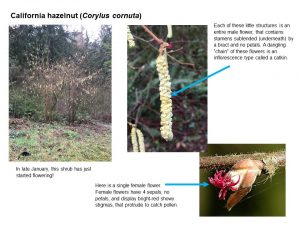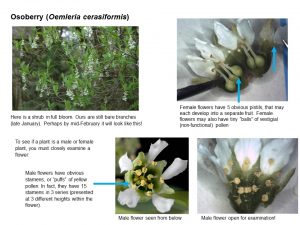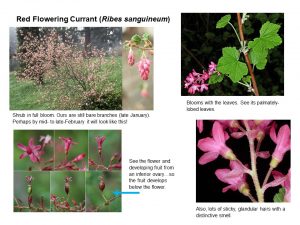Spring is coming, spring is coming, how do you think I know?
I saw some early wildflowers blooming, I know it must be so!
After our dark, dreary, damp, Pacific Northwest winters, we often look forward to longer days with some indications of the coming spring. A few of the earliest bloomers at Hoyt Arboretum (outside of the Winter Garden) are native shrubs that occur frequently along trails and in our abundant natural areas: California hazelnut, osoberry, and red flowering currant. These shrubs typically start blooming in early- to mid-February and have very showy blooms.
A few interesting facts on the identification of these shrubs:
California hazelnut (Corylus cornuta) – Common in many parts of the Arboretum. See large hazelnut shrubs near Stevens Pavilion, along the Redwood Trail and elsewhere.
- Deciduous large shrub to small tree
- Flowers appear on bare branches before leaves emerge
- Separate male and female flowers, but on the same plant!
- Male flowers are clustered in thin, elongated, dangling catkins
- Female flowers are tiny and single, with showy protruding bright-red stigmas (the sticky part of pistil that is ready to capture pollen)
- When leaves finally emerge, they are somewhat square-shaped with double-serrated margins and are soft and fuzzy (almost like toilet paper?)!
- Fruits eventually develop into a “hazelnut” with a hairy, beaked papery sheath, but are hard to find in the late summer as squirrels often find them first!


Osoberry (Oemleria cerasiformis) – Common in the Arboretum. There are showy shrubs near the Overlook Trail, near the large water tanks, and especially along the Oak Trail.
- Deciduous large shrub, leaves elliptic to narrow-obovate in shape, smooth margins
- Flowers appear with emerging leaves
- Shrubs are dioecious, meaning that there are separate male and female plants!
- Flowers in dangling racemes (looks like a mini-chain of flowers), white in color
- Male plants appear to have LOTS of flowers.
- Male (staminate) flowers with 15 stamens in 3 series (no pistils)
- Female (pistillate) flowers typically with 5 separate pistils, in which 2-5 of them develop into fruits.
- Female flowers may have vestigial (remnant, not viable) stamens
- Fruits are ellipsoid drupes, initially green turning yellow/orange/red, then maturing to blue-black in color in summer
- Fruits are edible, but not really choice. I have heard that birds like them!


Red Flowering Currant (Ribes sanguineum) – Present at the Arboretum, but not very common. See shrubs near the Stevens Pavilion, Overlook Trail, near the Wedding Meadow and near the start of the Redwood Trail.
- Deciduous shrub
- Flowers appear with emerging leaves
- Leaves palmately 3 to 5 lobed, serrated margins
- Flowers in axillary racemes, emerging upright and becoming pendent when in flower
- Flowers can be white to dark, coral red in color, parts in 5s, inferior ovary
- Fruit is a fleshy berry, dark purple-black in color with glandular hairs
- Fruits are edible (especially to birds), but are not tasty (to me)
Also…did you know that currants and gooseberries are very closely related? They are both in the genus Ribes and can be easily distinguished from one another by the presence/absence of thorns on the plant and prickles on fruits. Gooseberries have thorns and prickles, and currants do not.


So to recap…these are three easily-recognizable early blooming native shrubs for you to see and examine the next time you are out on a hike at Hoyt Arboretum or in one of our abundant local natural areas. Hope to see you on one of our trails as winter turns into spring!
About the Author


References:
Jepson Manual, Plants of California, eFlora
Images from:
Oregon State University’s Landscape Plants
Oregon Flora
